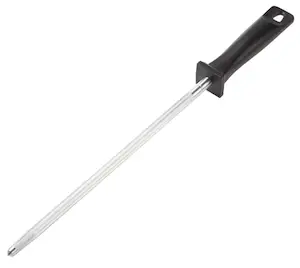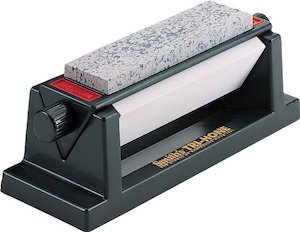Tips For Keeping The Knife Sharp
A knife is a tool that is of little use if it is not sharp. To maintain it in proper condition, it is necessary to tone the blade from time to time, depending upon the use. Keeping knives sharp is essential for efficient and safe cooking.
Here Are Some Tips On How To Maintain The Sharpness Of Your Knives:
- Use a Cutting Board:
- Always use a soft cutting board, such as wood or plastic, to minimize the impact on the knife edge. Avoid cutting on hard surfaces like glass, granite, or metal.
- Regular Honing:
- Use a honing rod or sharpening steel regularly to straighten and realign the edge of the blade. Honing doesn’t actually sharpen the knife but helps maintain its edge between sharpening sessions.
- Sharpening Stones:
- Invest in high-quality sharpening stones or whetstones. Regularly sharpen your knives using these stones to maintain a sharp edge. Follow the manufacturer’s guidelines for the specific stones you have.
- Angle Matters:
- Pay attention to the sharpening angle. Different knives have different recommended angles. For example, Western-style knives usually have a 20-degree angle, while Japanese knives may have a 15-degree angle.
- Consistent Technique:
- Maintain a consistent and controlled sharpening technique. Whether you’re using a honing rod or sharpening stones, keeping a steady angle and applying even pressure is crucial.
- Pull-Through Sharpeners:
- While pull-through sharpeners are convenient, be cautious as they can remove a significant amount of material quickly. Use them carefully and follow the instructions provided by the manufacturer.
- Stropping:
- Stropping involves using a leather strap to polish and refine the edge of the knife after sharpening. This can help achieve a razor-sharp finish.
- Hand WashWash - 1) Brushing or coating a food item with a liquid such as egg white; milk or egg wash. 2) The ... and Dry:
- Avoid putting knives in the dishwasher, as the high water pressure, heat, and harsh detergents can damage the blade. Instead, hand wash knives with mild soap and warm water, and dry them immediately with a soft cloth.
- Storage:
- Store knives properly to prevent them from dulling. Use a knife block, magnetic strip, or blade guards to keep the blades protected. Avoid putting knives in a drawer where they can come into contact with other utensils.
- Cutting Technique:
- Use proper cutting techniques to minimize stress on the blade. For example, rocking or chopping with the correct motion can reduce wear on the edge.
- Avoid Hard Foods and Surfaces:
- Refrain from cutting hard foods, bones, or frozen items with your kitchen knives. Also, avoid cutting on hard surfaces like ceramic plates or glass.
- Regular Maintenance:
- Make knife maintenance a routine. Regularly check the sharpness of your knives and address any dullness promptly.
Hence, it is very important to choose the correct mechanical knife sharpener and also regularly inspect the guiding angle for the blade to the stone to be set correctly.
Important Note: This information is brief and general, and should be only used as an example for preparing the hotel & kitchen staff training material. This article should not be the only source of your information on ‘How to Keep Knife or Knives Sharp?’. Normally the knife is sharpened using either by using 1) a Steel sharpener / Steel Rod or 2) Grinding stone.
1. How do Sharpen the Knife using a Steel Sharpener / Steel Rod?

- A Magnetized steel rod is used for this method of sharpening.
- The magnetized rod helps to remove burrs from the knife blade.
- To start, the knife is held in one hand.
- The base of the knife is placed at an angle of 20 degrees at the tip of the steel.
- The knife is then drawn across and down the length of the steel in one movement, keeping uniform pressure on the knife or the center of the blade this is to prevent uneven wear on the blade.
- The purpose is to return the cutting edge to a sharp ‘V’ and remove any burrs.
- The advantage of this process is that it removes very little actual metal from the knife blade.
- Use the steel regularly to keep a good edge on the knife.
2. How to Sharpen the Knife Using Grinding Stone?

- Sometimes all knives need to be downed using a grinding stone.
- A three-sided stone is normally used for this sharpening method.
- The Coarse side – is used to work thick heavy blades and also to remove large nicks.
- The Medium size – is used for medium-weight blades, like for example butcher knife.
- The Fine side – is used for light blades or knives, like for example boning knives.
- Before starting the process rub some water on the stone.
- Start at the tip of the knife and apply strong pressure down and forward so that the whole side of the blade is in contact with the stone.
- Make long figure 8 passes over the stone.
- Move back and forth while applying pressure, and keep the angle constant.
- Repeat on the other side.
- As the knives get thinner at the end, go to a finer side/stone.
- Using a grinding stone wears away the metal of the blade, therefore this method should not be used as a replacement for the metal rode method.
- Afterward, clean your knife, and remember to keep it sharp with a steel rod.
Remember that the frequency of sharpening depends on the usage and the type of knives you have. High-quality knives may need less frequent sharpening compared to lower-quality ones. Consistent care and proper technique will help keep your knives sharp and in good condition for a longer time. Additionally, there are several mechanical knife sharpeners available. But even though these mechanical knife sharpeners do a superior job in sharpening the knife, they remove an excessive amount of metal from the blade.











